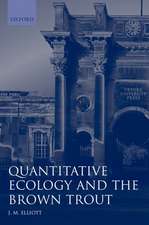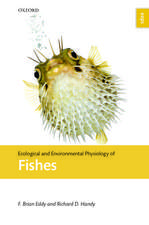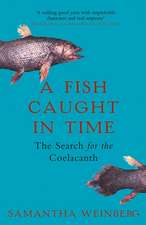Biology of the Spotted Seatrout: CRC Marine Biology Series
Editat de Stephen A. Bortoneen Limba Engleză Hardback – 30 iul 2002
This innovative reference provides current life history information on this species for the expressed purpose of beginning the task of assessing differences in estuarine restricted sub-populations of spotted seatrout. It serves as a model of a biological summary directed toward determining which of the life history parameters will most aptly serve as bioindicators to meet overall environmental management needs. It integrates estuarine specific life history features into the overall management of both estuaries and an estuarine dependent fishery.
Biology of the Spotted Seatrout includes a classic systematic approach to studying the relationships between seatrout genera as well as a more modern approach to investigating intra- and inter-estuarine differences in genetic structure. Ecologists, fisheries biologists and managers, and environmental scientists worldwide will be able to use the information presented in this book as a model on which to establish a database of information to be used to assess and compare estuarine conditions and environmental health. This valuable book serves as a blueprint for bringing together the biological criteria necessary to begin landscape scale comparisons of estuaries based on the biological information of totally estuarine dependent species, such as the spotted seatrout.
Din seria CRC Marine Biology Series
- 9%
 Preț: 608.33 lei
Preț: 608.33 lei -
 Preț: 389.80 lei
Preț: 389.80 lei - 9%
 Preț: 785.46 lei
Preț: 785.46 lei - 8%
 Preț: 423.12 lei
Preț: 423.12 lei - 18%
 Preț: 1373.17 lei
Preț: 1373.17 lei - 18%
 Preț: 824.43 lei
Preț: 824.43 lei - 9%
 Preț: 700.54 lei
Preț: 700.54 lei -
 Preț: 442.89 lei
Preț: 442.89 lei - 15%
 Preț: 470.20 lei
Preț: 470.20 lei - 14%
 Preț: 313.87 lei
Preț: 313.87 lei - 10%
 Preț: 327.14 lei
Preț: 327.14 lei - 24%
 Preț: 430.21 lei
Preț: 430.21 lei - 18%
 Preț: 1353.68 lei
Preț: 1353.68 lei - 18%
 Preț: 836.26 lei
Preț: 836.26 lei - 18%
 Preț: 1014.77 lei
Preț: 1014.77 lei - 9%
 Preț: 1246.80 lei
Preț: 1246.80 lei - 26%
 Preț: 1019.22 lei
Preț: 1019.22 lei
Preț: 1556.55 lei
Preț vechi: 1898.23 lei
-18% Nou
Puncte Express: 2335
Preț estimativ în valută:
297.85€ • 311.61$ • 247.42£
297.85€ • 311.61$ • 247.42£
Carte tipărită la comandă
Livrare economică 03-17 aprilie
Preluare comenzi: 021 569.72.76
Specificații
ISBN-13: 9780849311291
ISBN-10: 0849311292
Pagini: 328
Ilustrații: 84 b/w images, 8 color images, 46 tables and 22 halftones
Dimensiuni: 178 x 254 x 24 mm
Greutate: 0.79 kg
Ediția:1
Editura: CRC Press
Colecția CRC Press
Seria CRC Marine Biology Series
ISBN-10: 0849311292
Pagini: 328
Ilustrații: 84 b/w images, 8 color images, 46 tables and 22 halftones
Dimensiuni: 178 x 254 x 24 mm
Greutate: 0.79 kg
Ediția:1
Editura: CRC Press
Colecția CRC Press
Seria CRC Marine Biology Series
Public țintă
ProfessionalCuprins
Preface
Acknowledgements. Editor. Introduction. Taxonomy Of The Sea Trout Genus Cynoscion (Pisces, Sciaenidae) With Artificial Keys To The Species. Population Structure Of The Spotted Seatrout (Cynoscion nebulosus) Along The Texas Gulf Coast, As Revealed By Genetic Analysis. Population Structure Of The Spotted Seatrout, Cynoscion nebulosus, Along The Atlantic Coast Of The United States. Age Determination And Growth Of Spotted Seatrout, Cynoscion nebulosus. Estuary Specific Age And Growth Of Spotted Seatrout In The Northern Gulf Of Mexico. The Demographics And Reproductive Biology Of Spotted Seatrout, Cynoscion nebulosus In Six Northwest Florida Estuaries. The Reproductive Biology Of Spotted Seatrout. Effects Of Variable Salinity On Reproduction And Early Life Stages Of Spotted Seatrout. Culture Of Spotted Seatrout, (Cynoscion nebulosus). Spotted Seatrout Habitat Affinities In Louisiana. Sound Production and Communication in the Spotted Seatrout. Diseases and Parasites of the Spotted Seatrout, Management of Spotted Seatrout and Fishery Participants in the U.S. Modeling the Distribution and Abundance of Spotted Seatrout: Integration of Ecology and GIS Technology to Support Management Needs. A Spatial Ecosystem Model to Assess Spotted Seatrout Population Risks from Exploitation and Environmental Changes. Spotted Seatrout as a Potential Indicator Of Estuarine Condition.
Acknowledgements. Editor. Introduction. Taxonomy Of The Sea Trout Genus Cynoscion (Pisces, Sciaenidae) With Artificial Keys To The Species. Population Structure Of The Spotted Seatrout (Cynoscion nebulosus) Along The Texas Gulf Coast, As Revealed By Genetic Analysis. Population Structure Of The Spotted Seatrout, Cynoscion nebulosus, Along The Atlantic Coast Of The United States. Age Determination And Growth Of Spotted Seatrout, Cynoscion nebulosus. Estuary Specific Age And Growth Of Spotted Seatrout In The Northern Gulf Of Mexico. The Demographics And Reproductive Biology Of Spotted Seatrout, Cynoscion nebulosus In Six Northwest Florida Estuaries. The Reproductive Biology Of Spotted Seatrout. Effects Of Variable Salinity On Reproduction And Early Life Stages Of Spotted Seatrout. Culture Of Spotted Seatrout, (Cynoscion nebulosus). Spotted Seatrout Habitat Affinities In Louisiana. Sound Production and Communication in the Spotted Seatrout. Diseases and Parasites of the Spotted Seatrout, Management of Spotted Seatrout and Fishery Participants in the U.S. Modeling the Distribution and Abundance of Spotted Seatrout: Integration of Ecology and GIS Technology to Support Management Needs. A Spatial Ecosystem Model to Assess Spotted Seatrout Population Risks from Exploitation and Environmental Changes. Spotted Seatrout as a Potential Indicator Of Estuarine Condition.
Recenzii
"There is a large amount of information presented that should be useful not only for those studying spotted seatrout and their estuarine homes but also for those searching for sentinel species for other waters."
--Copeia, 2003, No. 1
--Copeia, 2003, No. 1
Descriere
Prepared by the foremost authorities in their respective fields, Biology of the Spotted Seatrout integrates estuarine specific life history features into the overall management of both estuaries and an estuarine dependent fishery. It presents a classic systematic approach to studying the relationships between seatrout genera as well as a more modern approach to investigating intra- and inter-estuarine differences in genetic structure. The book serves as a model of a biological summary directed toward determining which of the life history parameters will most aptly serve as bioindicators to meet overall environmental management needs.












